Would your team be more productive if you knew exactly how they spent their work hours?
You hire talented people because you trust them to do their jobs well. But how can you tell if they’re truly focused on their work—or if hours are slipping away on distractions?
What if you could track productivity, ensure accountability, and eliminate time-wasting, all while giving employees the flexibility and autonomy they need to do their best work?
That’s the balance that employee monitoring software aims to achieve.
Some believe workplace monitoring feels too much like micromanagement, but when done ethically and transparently, it actually protects employees, improves efficiency, and fosters trust.
Table of Contents
- Why employee monitoring matters today
- The pros of employee monitoring
- The cons of employee monitoring
- Time Doctor: the best employee monitoring tool
Let’s get started.
Why employee monitoring matters today
Workplace expectations have changed. With remote work becoming the norm and businesses relying more on digital collaboration tools, companies now face new challenges:
- How do you ensure remote employees stay productive without micromanaging them?
- How do you evaluate performance fairly when you can’t physically see who’s working?
- How do you prevent cybersecurity threats and ensure data security when employees have access to sensitive company data?
At the same time, concerns around trust, privacy, and fairness are growing. Employees want to feel valued—not just monitored. They also want to experience employee engagement in a workplace that supports their growth. Employers, on the other hand, need clear data collected to optimize productivity and ensure accountability.
That’s why so many companies are turning to employee monitoring software—not to spy on employees, but to create a structured, fair, and productive work environment.
So, does employee monitoring software actually help businesses succeed? Or does it cause more harm than good?
Let’s explore the real pros and cons of employee monitoring—and how the right approach can transform your workplace without sacrificing trust or privacy.
The pros of employee monitoring
Managing a team—whether in the office or remotely—has become even more complex since the pandemic, as companies adjust to new work environments. You want to ensure productivity, but you also don’t want employees to feel like they’re under constant surveillance.
So how do you find the right balance?
The key is implementing employee monitoring the right way—with clear monitoring policies that promote transparency, accountability, and productivity, rather than excessive control. When used correctly, employee monitoring software offers valuable insights that benefit both employers and employees.
Let’s take a closer look at how monitoring tools can help create a fairer, more efficient, and more secure work environment.
1. It creates fairness and accountability
How do you ensure that everyone on your team is putting in the same level of effort?
Without clear data, some employees may carry more of the workload while others go unnoticed. For businesses that rely on mobile teams, GPS tracking helps ensure work is fairly distributed based on real-time location data. And in a remote work environment, the challenge is even greater—how do you know if an employee is actively working or just appearing online?
This is where employee monitoring software makes a difference. By tracking work hours, employee’s computer activity, and time spent on projects, managers get an accurate view of who is truly contributing.
But it’s not just about managers—employees benefit, too. With a time tracking tool, they no longer have to justify the time spent on tasks. Instead, their work speaks for itself through accurate records. This builds trust and fairness in the workplace, which can positively impact retention by fostering a supportive and transparent environment.
Addressing the “fake work” problem
With remote work on the rise, some employees have found ways to appear active without actually working—like using mouse jigglers to prevent their screens from going idle.
Many companies are now cracking down on “fake work” because it skews productivity reports and creates unfair workloads.
Employee Monitoring Software eliminates this problem. Instead of tracking just screen activity, it provides detailed reports on real work completed, including:
- Actual tasks worked on
- Websites and apps used
- Time spent on meaningful activities
This ensures that businesses measure real productivity—not just keyboard movement.
When everyone is held accountable, productivity naturally increases. Employees feel more confident knowing their hard work is recognized and that expectations are clear.
2. It helps track and improve productivity
How productive is your team—really?
If you’re guessing, you might be overlooking inefficiencies that cost time and money.
Studies have shown that employee monitoring can significantly boost productivity by reducing distractions and improving time management. Research indicates that when employees know their work is being tracked, they are more likely to stay focused and complete tasks efficiently.
A productivity tracking tool eliminates the need for assumptions. With employee performance data, businesses can identify key trends, such as:
- Work patterns: Are employees most productive in the morning or afternoon?
- Time management gaps: Are employees spending too much time on certain tasks?
- Bottlenecks: Are specific processes slowing down workflows?
Leveraging AI for smarter productivity tracking:
As AI reshapes the workplace, businesses need more than basic tracking tools.
Employee monitoring software uses AI-powered insights to help managers spot inefficiencies, optimize schedules, and make informed decisions—without micromanaging employees.
Instead of relying on activity tracking alone, it helps companies understand:
- Why certain tasks take longer
- Which processes need improvement
- How to optimize workloads for better efficiency
By using AI-driven insights, businesses can refine workflows, prevent burnout, and improve overall productivity.
3. It sets clear standards for workplace behavior
In any workplace, expectations around acceptable work behavior should be crystal clear. But in remote teams, it’s harder to enforce guidelines.
For example:
- Should employees be allowed to browse personal websites during breaks?
- Are certain apps considered distractions, or do they play a role in work?
- How do you know if someone is actually working or just looking busy?
This is where an employee monitoring system provides clarity and consistency. By tracking website usage and application activity, businesses can ensure compliance with company policies while setting clear expectations—without micromanaging.
Instead of blocking sites or assuming the worst, managers can use data-driven insights to guide conversations about workplace behavior. Employees also gain a better understanding of what’s considered acceptable and productive use of time.
The goal isn’t to limit employees—it’s to create a fair work environment where expectations are clear and everyone is on the same page.
4. It identifies top performers and helps struggling employees
Wouldn’t it be easier to reward hard-working employees if you had clear data showing their contributions?
One of the biggest benefits of employee monitoring tools is that they make performance evaluation more objective. Instead of relying on manager observations or subjective feedback, businesses can use real work data to:
- Recognize employees who consistently exceed expectations
- Identify team members who need extra training or support
- Ensure workload is balanced so no one is overworked
For underperforming employees, this data helps managers pinpoint specific challenges and offer targeted solutions—whether it’s additional training, workflow adjustments, or more efficient tools.
At the same time, top performers can be acknowledged and rewarded, creating a culture where hard work is visible and valued.
5. It prevents billing disputes and ensures fair pay
If your company works with freelancers, contractors, or remote employees, how do you know you’re paying them fairly?
With time tracking software, businesses can verify work hours and ensure that invoices are accurate and transparent. Instead of questioning whether a 10-hour project actually took 10 hours, you’ll have clear records of:
- Time worked on specific tasks
- Websites and apps used during billable hours
- Breaks and idle time, ensuring active work hours are tracked
This protects both businesses and employees. Freelancers and remote workers can prove their time investment, avoiding disputes. Meanwhile, businesses can trust that they’re paying for real work, not unverified hours.
It’s a win-win for both sides, ensuring fair compensation and trust in the payment process.
6. It enhances security and prevents data breaches
Would you feel comfortable knowing that employees could access or share sensitive company data without any oversight?
Cybersecurity threats are more serious than ever, and human error is one of the biggest risks. Employees may unintentionally:
- Download unsafe files that contain malware
- Click on phishing emails that steal company credentials
- Share sensitive data on unauthorized platforms
A monitoring system acts as a first line of defense, alerting managers to suspicious activities before they turn into major security breaches. Some businesses also integrate video surveillance with employee monitoring software to protect company assets and prevent unauthorized access.
But security isn’t just about catching mistakes—it’s also about prevention. When employees know that company devices and data are monitored, they’re naturally more cautious. This reduces the risk of accidental data leaks, unauthorized downloads, or security breaches.
Beyond cybersecurity, employee monitoring software also helps businesses track insider threats—such as employees attempting to access restricted files or share confidential information.
For companies handling client data, intellectual property, or financial records, a secure monitoring system is essential to protect business operations.

The cons of employee monitoring
While employee monitoring software offers employee productivity insights, security benefits, and accountability, it’s natural for employees to have concerns about how it’s used. Some fear privacy violations, while others worry about a lack of trust or excessive oversight.
But does employee monitoring have to be a negative thing?
The truth is, when introduced the right way, workplace monitoring tools can improve transparency, foster trust, and even help employees achieve better work-life balance. Let’s explore some of the most common concerns and how businesses can turn them into opportunities for improvement.
1. Employee monitoring invades privacy
One of the employees’ biggest concerns is that monitoring software might track personal data, messages, or even passwords. No one wants to feel like they are under constant surveillance, especially in a remote work environment where professional and personal lives sometimes overlap.
Employees may ask:
- Does the company monitor my personal emails and messages?
- Can they see my passwords and sensitive information?
- Am I being watched even outside of work hours?
These concerns are understandable, but they stem from outdated or unethical monitoring practices. Modern employee monitoring software is designed to track only work-related activity, not personal data.
Employers can ease these worries by:
- Being transparent about what’s being tracked and what is off-limits
- Ensuring employees have full control over when monitoring starts and stops
- Clearly stating that private communications and passwords are never recorded
When companies handle workplace monitoring responsibly, it creates transparency rather than violating privacy. Employees feel safer knowing that only their work performance—not their personal life—is being monitored.
2. Monitoring software destroys trust in the workplace
If workplace monitoring is introduced poorly, employees might assume their employer doesn’t trust them. When employees feel like they’re being watched just to catch mistakes, it can:
- Lower employee morale and make employees feel undervalued
- Create a culture of fear, where people worry about every small action
- Increase employee turnover, as workers look for a more trusting environment
However, employee monitoring doesn’t have to be about suspicion—it can be about support. When used transparently and fairly, monitoring helps teams:
- Showcase their productivity without needing to prove themselves constantly
- Highlight hard work that might otherwise go unnoticed
- Gain better work-life balance by ensuring workloads are fair
The key is in how monitoring is implemented. When companies explain that everyone—including leadership—is monitored, it stops feeling like spying and becomes a standard productivity tool that benefits the entire organization.
3. Employees feel pressured to always be “active”
Some employees may worry that if their screens are idle for a few minutes, monitoring software will flag them as unproductive. This can lead to:
- Unnecessary stress, where employees feel they have to look busy all the time
- Fewer breaks, which actually reduce focus and creativity
- A culture of burnout, where employees hesitate to step away even when needed
But productivity isn’t just about constant activity—it’s about output and efficiency. A good employee monitoring system doesn’t just track time; it helps optimize work habits by:
- Allowing flexibility while still providing accountability
- Encouraging smart time management, not just staying online for the sake of it
- Helping managers better understand employee workloads, ensuring no one is overworked
The best monitoring tools track productivity, not just motion, allowing employees to work at their own pace while staying efficient.
4. Employee tracking software can be misused
Not all businesses implement employee monitoring ethically. In some cases, employers overuse monitoring tools, turning them into micromanagement tools instead of productivity aids. This can lead to:
- Excessive surveillance, where employees feel they have no privacy at all
- Over-dependence on tracking data without considering real employee performance
- A hostile work environment, where every action is scrutinized
However, monitoring software should be a tool for insight, not a weapon for control. Companies can prevent misuse by:
- Focusing on results, not just screen time
- Using monitoring to support employees, not punish them
- Allowing employees to access their own productivity reports, giving them control over their performance metrics
When used ethically, employee monitoring improves workflows and efficiency instead of making employees feel trapped.
5. Data tracking doesn’t always reflect real productivity
Many businesses assume that monitoring software gives them the full picture of an employee’s productivity. But the truth is, not all work is measurable by keystrokes or screen activity.
For example:
- A writer or designer may spend time thinking, brainstorming, or sketching ideas—which might not show up as active time
- A manager might have important meetings and calls that don’t reflect in tracking reports
- Some employees work in deep focus mode, meaning fewer clicks but more meaningful work
Companies that rely too much on data alone might misinterpret productivity, assuming that someone who types a lot is more productive than someone who spends time strategizing.
To avoid this, businesses should:
- Combine tracking data with human judgment in performance evaluations
- Encourage discussions about productivity rather than making assumptions from numbers
- Recognize different work styles—some jobs require more deep thinking, which might not show up as “active time.”
When companies use monitoring insights alongside real-world understanding, they can balance data-driven decisions with human intelligence.
6. Poor implementation can create confusion and resistance
If a company rolls out employee monitoring software without clear communication, employees may push back or misunderstand its purpose. This can lead to:
- Fear and uncertainty about what’s being tracked
- Resistance from employees, believing the software is unfair
- A lack of adoption, where employees find ways to work around the system
To prevent this, companies should:
- Clearly explain how the software works before launching it, including whether screenshots will be used and how frequently
- Highlight the benefits for employees, not just for managers
- Offer training and open discussions to ensure everyone understands how monitoring helps improve efficiency and fairness
When employees see monitoring as a tool that allows them, they’re more likely to accept and even appreciate its role in creating a better workplace.
What are the best employee monitoring tools?
With so many employee monitoring software solutions available, how do you know which one is right for your business? The best tools help companies track productivity, ensure accountability, and optimize workflows—all without overstepping into excessive surveillance.
But not all tools are created equal. Some focus solely on time tracking, while others offer comprehensive employee performance monitoring, including website and app usage tracking, automated reporting, and even distraction management.
If you want a deep dive into the best employee monitoring software options, check out our comprehensive guide to the top tools. It breaks down different solutions’ features, pricing, and benefits, so you can find the one that fits your needs best.
That said, one solution stands out if you’re looking for a monitoring tool that balances productivity, privacy concerns, and ease of use.
Time Doctor: the best employee monitoring tool

To get the benefits of employee monitoring—without the downsides—you need the right software.
That’s where Time Doctor comes in.
Unlike traditional workplace monitoring tools that focus only on tracking time, Time Doctor goes further—helping businesses boost productivity, improve team efficiency, and create a fairer work environment. It provides the insights companies need without invading employee privacy or creating a culture of excessive surveillance.
Why choose Time Doctor?
There are plenty of employee monitoring tools out there, but not all of them are built with both employers and employees in mind. Some tools focus too much on surveillance, making workers feel micromanaged. Others provide too little insight, leaving businesses with incomplete productivity data.
That’s why Time Doctor stands out—it helps businesses track employee activity, optimize productivity, and improve accountability without making employees feel like they’re being watched every second.
It’s not just about time tracking—it’s about helping teams work smarter, stay engaged, and maintain a healthy work-life balance.
Here’s what makes Time Doctor the best choice
1. Easy to use—no complicated setup
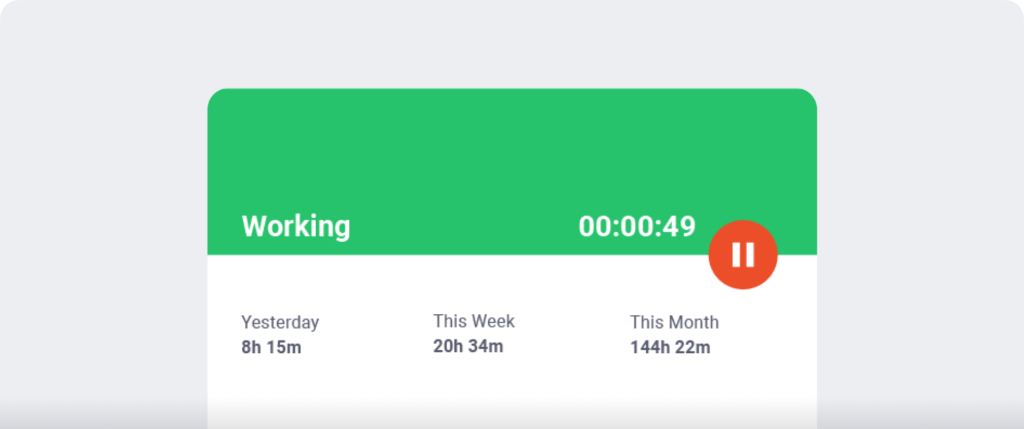
A monitoring tool is only effective if people actually use it. Some employee tracking software can feel overwhelming with too many unnecessary features.
With Time Doctor, simplicity is key. Employees can start and stop the timer whenever they work, giving them full control over their tracked time. Whether they’re working on in-office tasks, remote projects, or client work, they can log their hours effortlessly without disrupting their workflow.
2. Privacy-friendly—monitor productivity, not personal time
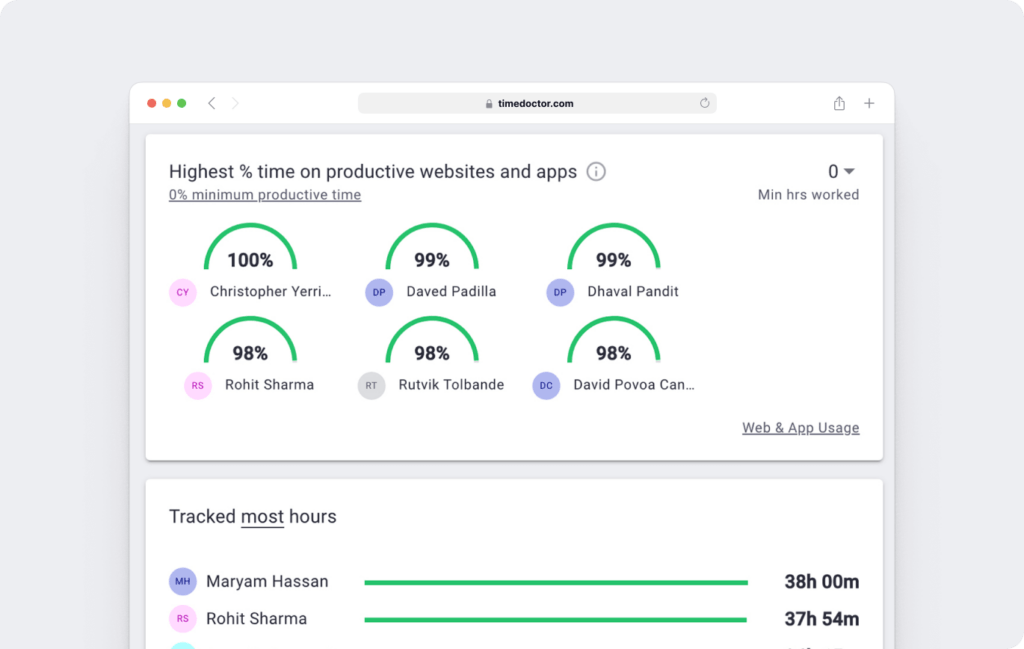
One of the biggest concerns employees have about workplace monitoring is privacy. Nobody wants to feel like their boss is watching their every move.
Unlike some invasive monitoring tools, Time Doctor ensures that employees manage their own tracking. There are no hidden surveillance tactics, keystroke logging, or secret screen recordings—just transparent, ethical tracking that benefits everyone.
Employers get accurate work records, and employees can rest easy knowing their privacy is respected.
The good news? Time Doctor only tracks work-related activity—never personal data. It also ensures businesses stay compliant with privacy laws like GDPR and CCPA, so employees’ personal information is always protected.
When companies are upfront about what they track (and what they don’t), employees feel more comfortable, and monitoring becomes a tool for productivity—not surveillance. Being transparent also helps businesses stay compliant with privacy laws. Ignoring these regulations could lead to legal issues or hurt the company’s reputation.
3. Productivity insights—see where time is spent, without micromanaging
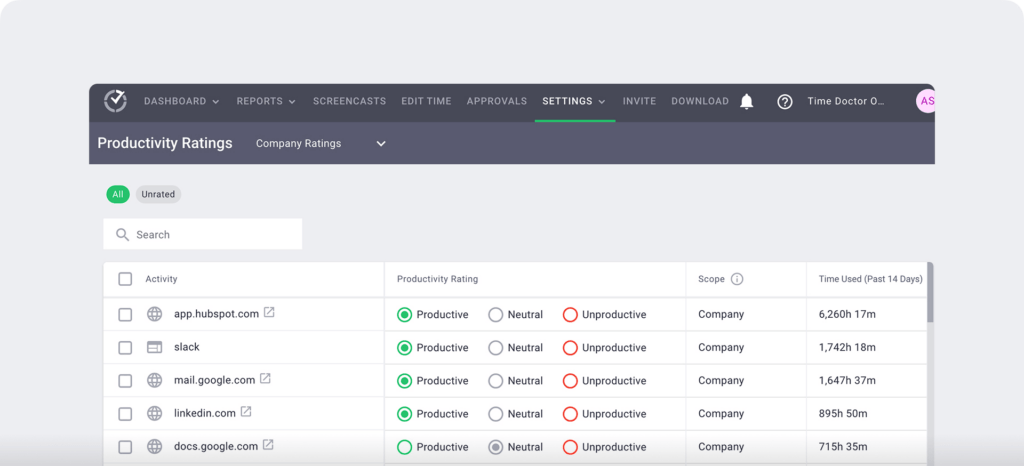
Tracking hours is just one part of the equation. The real question is: how is time being spent?
With Time Doctor’s productivity insights, businesses get a clear picture of employee performance by tracking:
- Time spent on specific tasks and projects
- Websites and apps used during work hours
- Trends in productivity over days, weeks, or months
Instead of guessing where time is going, managers can use real data to help employees work more efficiently—without the need for constant check-ins.
4. Distraction alerts—keep employees focused without pressure
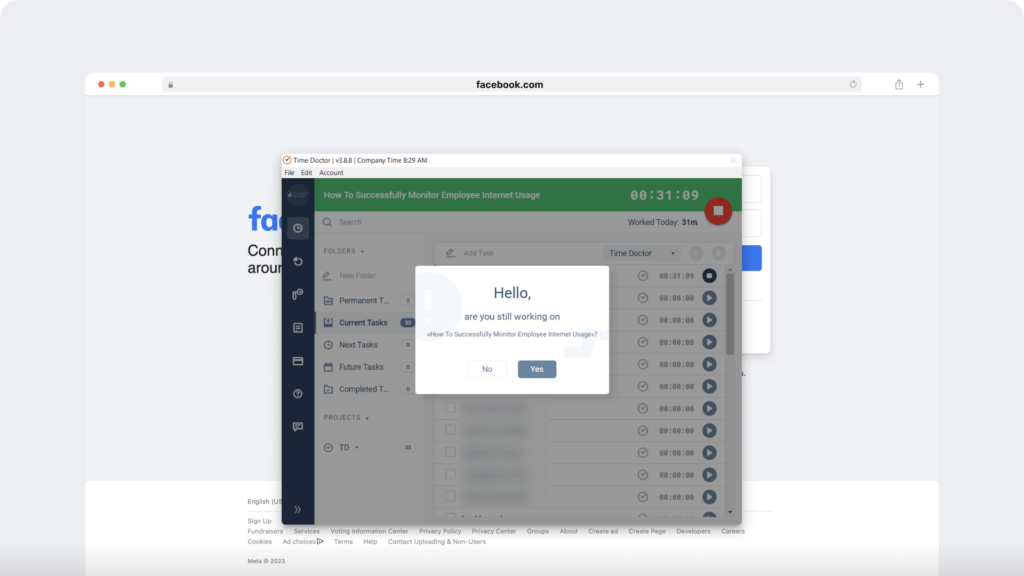
Even the best employees get distracted—whether it’s checking social media, browsing non-work-related websites, or simply losing focus.
That’s why Time Doctor includes gentle distraction alerts. If an employee spends too much time on an unproductive site, they receive a subtle reminder to get back on track.
It’s not about punishing employees for short breaks—it’s about helping them stay focused and use their time wisely.
5. Accurate billing—ensure businesses and clients only pay for real work
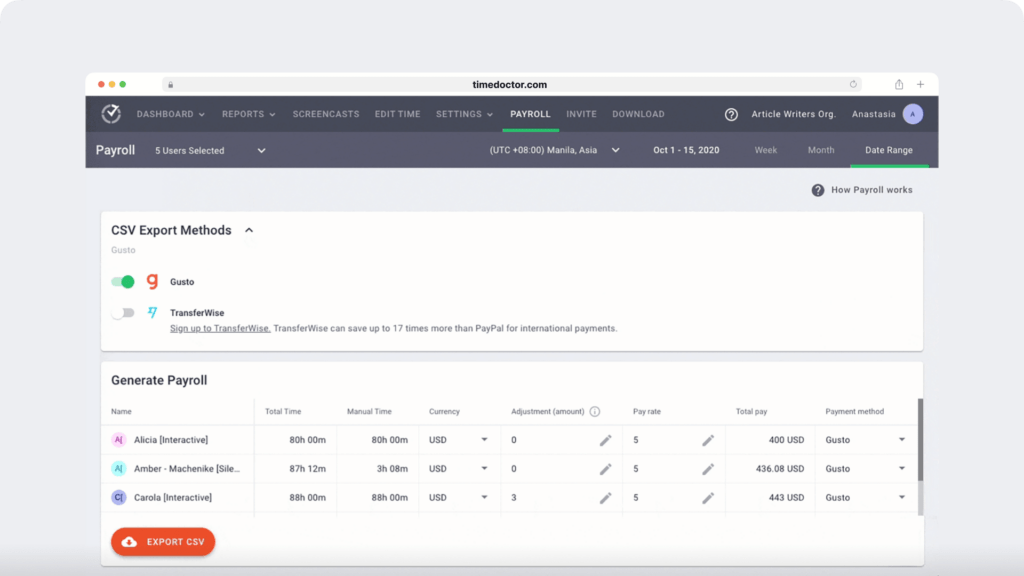
For companies that work with freelancers, remote employees, or bill clients by the hour, accurate time tracking is essential.
Time Doctor provides verifiable work records showing exactly:
- How long an employee worked on a task
- What websites and apps were used during that time
- How much time was spent on different projects
This eliminates billing disputes, ensures fair pay, and makes payroll simpler and more transparent.
More than just monitoring—Time Doctor helps teams work smarter
Time Doctor isn’t just about tracking work hours. It’s about understanding productivity trends, identifying bottlenecks, and helping employees perform at their best.
For businesses that want accurate employee activity tracking—without making employees feel like they’re constantly being watched—Time Doctor is the solution that gets it right.
How Time Doctor solves common monitoring concerns
While employee monitoring software boosts productivity and accountability, some employees and managers hesitate due to concerns about privacy, fairness, and usability. Choosing a tool that balances monitoring with trust is key.
That’s where Time Doctor stands out. It tracks employee activity and performance while ensuring transparency and privacy. Instead of feeling watched, employees gain insights to work more efficiently, manage time better, and stay focused.
Here’s how Time Doctor addresses common monitoring concerns with practical solutions.
| Concern | Time Doctor solution |
| Employees fear loss of privacy | Employees control when tracking starts and stops, ensuring they are never monitored outside of work hours. No hidden tracking, just transparent monitoring. |
| Managers struggle to track work hours | Automatic time tracking and project reports ensure accurate records of hours worked—without the need for micromanagement. |
| Employees get distracted easily | Gentle reminders help employees refocus when they spend too much time on unproductive sites. |
| Billing clients is confusing | Accurate timesheets and activity tracking provide verifiable proof of billable hours, eliminating disputes overtime worked. |
| Monitoring feels like micromanagement | Time Doctor helps managers focus on performance and output rather than just hours logged, creating a results-driven work environment. |
| Some tasks require deep work and minimal screen activity | Time Doctor recognizes that not all work happens on a keyboard. It allows businesses to track productivity trends over time rather than relying only on real-time activity. |
| Employees worry about being unfairly judged based on tracking data | Employees can access their own productivity reports, giving them full visibility into their tracked time and allowing them to manage their workflow proactively. |
| Remote teams struggle with accountability | With Time Doctor, remote teams can track task completion, time spent on projects, and internet usage, making it easier to measure performance without constant check-ins. |
| Managers don’t have time to analyze productivity reports | Automated reports and analytics dashboards make it easy to review team productivity at a glance without spending hours on employee data analysis. Time Doctor also provides integrations with third-party analytics tools, ensuring businesses get deeper insights into workforce performance. |
| Some monitoring tools feel invasive | Unlike traditional surveillance tools, Time Doctor is designed for ethical employee tracking, ensuring privacy while still helping businesses stay productive. |
Final thoughts
What if the key to a more productive, efficient, and engaged workforce isn’t about working harder—but working smarter?
Employee monitoring software isn’t just about tracking hours or watching what employees do. When used the right way, it eliminates guesswork, helps teams stay focused, and ensures fairness in the workplace. It provides the transparency that both employers and employees need to work more effectively—without overstepping into micromanagement.
But here’s the real question:
How much productivity, efficiency, and potential growth is your business losing because you don’t have clear visibility into how work gets done?
The right employee monitoring solution isn’t about surveillance—it’s about empowering employees, improving workflows, and helping businesses succeed.
So, what would your workplace look like if everyone had the tools to perform at their best—without unnecessary distractions or inefficiencies?
Your team’s potential is limitless—but only if you have the right tools to harness it. Without clear insights, productivity gaps go unnoticed, time is wasted, and business growth slows down.
Time Doctor gives you the visibility, accuracy, and flexibility you need to track performance, eliminate distractions, and ensure fair workloads—without making employees feel micromanaged.
Ready to see the difference?
Discover how Time Doctor can help you boost productivity, streamline workflows, and build a more efficient, engaged workforce.

Liam Martin is a serial entrepreneur, co-founder of Time Doctor, Staff.com, and the Running Remote Conference, and author of the Wall Street Journal bestseller, “Running Remote.” He advocates for remote work and helps businesses optimize their remote teams.


